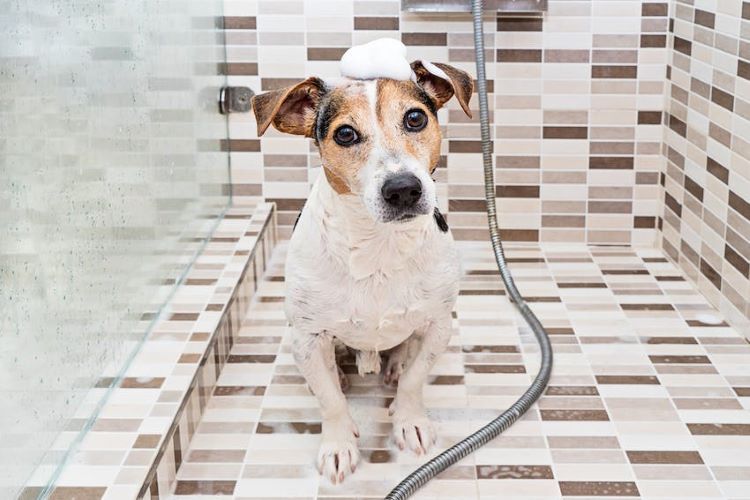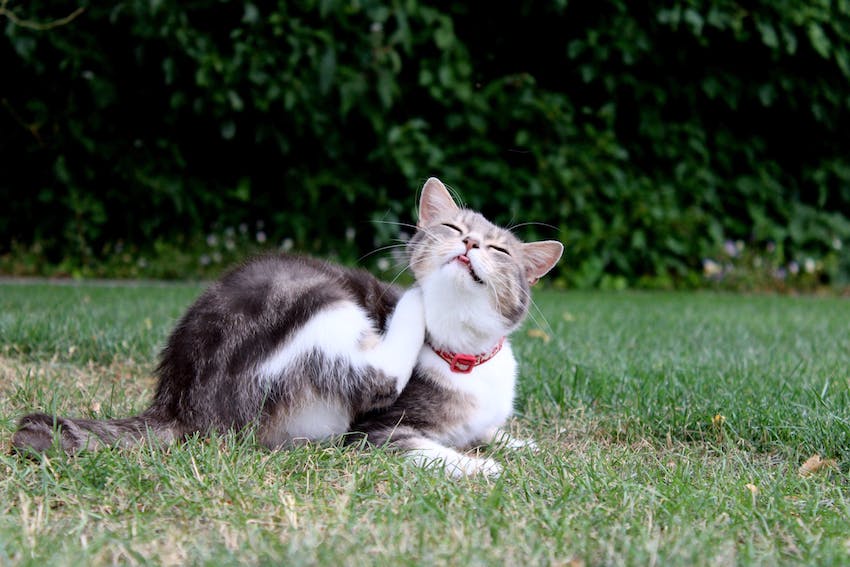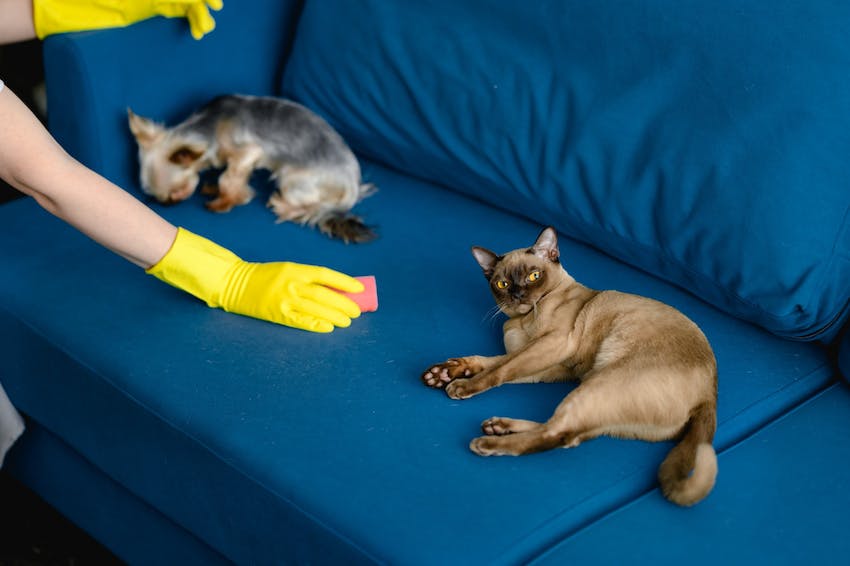Ready to help treat your pet to a healthy life?
How to Get Rid of Fleas: A Guide for Pet Owners
By : Brianna Gunter | Updated Sep 5, 2024

Fleas are a worst nightmare situation for many pet owners. And when you find out your four-legged friend has them, it’s normal to have a lot of questions:
How did this happen to my dog/cat? Does this mean I’m a bad pet owner?
Are fleas dangerous to humans? How bad are fleas for pets anyway?
Do fleas go away on their own?
Okay, I don’t think they do. How do I get rid of fleas as fast as possible?
Before you do anything else, take a moment to breathe. Your cat or dog having fleas does not mean you are a bad pet owner, and infestations pop up in households all over the world. Even if you've recently started monthly flea prevention treatments, they won't be that much help if your pet (and your home) already has an infestation in progress.
The good news is that while fleas are tricky pests to go to battle with, they can be beaten. In fact, there are a variety of things you can do to get rid of them. In order to boost your odds of success, it’s important to understand how pets get fleas and the dangers these small external parasites pose to animals and humans alike.
How dogs and cats get fleas
As powerful jumpers that can leap up to 150 times their own height, fleas easily hop onto your pet from their surroundings. Once on, fleas quickly make their way down through your pet’s fur to the skin. This, combined with the fact that they’re very small, makes it difficult to spot fleas early on.

“Typically your pet picks up fleas from an environment infested with fleas,” says Trupanion veterinarian Dr. Sarah Nold. “However, they could also get fleas from being close to other pets with fleas.”
In addition to infested spaces (homes, dog parks, veterinary clinics, etc.) and other animals, fleas come from the outdoors and are generally found in grass and wooded areas. But by the time you notice your pet’s coat has become a metropolis of tiny, dark jumping insects, it’s likely that the fleas have been there for a while.
Adult female fleas lay 25 eggs a day and live for a week. These eggs are tiny ovals that are white or translucent, so it’s incredibly challenging to notice them with the naked eye. These eggs hatch into larvae, which develop into adult fleas within 26 days.
As Flea Science explains, “Assuming a dog acquires 5 female fleas, and 25% of their eggs survive, within a month the infestation would grow to over 4,000 fleas.”
Signs of flea infestation on pets
Not sure if your dog or cat has fleas? Fleas can easily hide on your four-legged friend, especially if they have long or thick fur. With this in mind, keep on the lookout for these additional signs of flea infestation:
- Excessive scratching
- Self-biting
- Hair loss
- Red-appearing skin
Are fleas dangerous?
Fleas are seen as a nuisance, but are they actually a danger to pets and people? Aside from causing itching and general skin irritation, fleas can carry certain illnesses that can affect both humans and animals. According to the Centers for Disease Control and Prevention (CDC), these primarily include flea-borne typhus, plague, and cat-scratch disease. Left untreated, these illnesses can be fatal.
Ready to take action against those pesky fleas? It’s important to start as soon as possible, as waiting will only help the infestation get worse. Don’t worry — you’ve got this.

How to get rid of fleas: 7 key steps
1. Consult with your veterinarian
One of the first things you should do when confronted with a pet flea infestation is give your local veterinary clinic a call. They will be able to provide treatment information, including recommendations for care that are specific to your pet’s coat type and medical history. For example, a dog with previous skin issues may not be able to receive the same drugstore flea treatment as other canines.
Keep in mind that bringing a pet with fleas to a veterinary practice is not recommended, as this can easily spread the infestation to other animals.
2. Bathe your pet
Thoroughly bathing your pal from head to toe is among the most necessary parts of pet flea treatment. Ideally, you’ll want to take a longer time than you would during a normal pet bath, going until you no longer see any fleas being rinsed out. Choose your soap wisely too. According to Pet Keen, common household dish soap offers a gentler option for pets with highly irritated skin, but it may not be the most effective in killing fleas.
If you live in a multi-pet household, bathe all animals regardless of whether they are visibly affected by fleas as a precaution. Bonus tip — you may want to trim your cat’s nails first (you don’t need scratches on top of your flea battle).
3. Use a flea treatment
In addition to bathing with soap, a flea treatment with insecticide is needed to handle infestations that go beyond just a few bugs (which is most by the time they’re noticed). Since flea treatments come in a variety of forms (including topical and oral variants), talk with your veterinarian about which will be the safest, most effective option for your pet.
Flea treatment is generally not covered by pet insurance, as infestations are considered preventable. (Learn more about the wide range of conditions Trupanion covers).
4. Don’t just focus on adult fleas
In order to beat a flea infestation long-term, it’s vital to tackle all stages of the flea life cycle. Use a flea comb to carefully go through your pet’s fur and remove any traces of the little bugs, from eggs to larvae to adults.
Don’t forget about “flea dirt” either! These small specks of brown material (some pet owners liken it to black pepper) are actually digested blood from your pet that adult fleas leave behind. Hatching larvae eat this material, so be sure to remove any flea dirt that you come across.
5. Clean your home
Fleas tend to breed and congregate in bedding, blankets, couches, and rugs. That said, they can be found on all kinds of surfaces throughout your home. In order to prevent new fleas from making their way onto your pet, it’s vital to clean everything from top to bottom. Don’t forget to clean under rugs and alongside wall edges. And be sure to use pet-friendly cleaning products while you're at it!
Remember — treating your pet directly is only half the battle. Keeping your home clean throughout will help prevent spread and reoccurrence.
6. Repeat
Fleas have a complex life cycle that leaves them more resistant to flea treatment insecticides at certain point of their lifespan. At the same time, the fleas on your pet are likely at all different life stages. In order to make sure they’re all vanquished, you’ll need to repeat topical treatments within a week after the first application. Deep house cleaning should also be continued throughout this period.
More severe infestations may require treatment and cleaning repetition for months, but talk with your veterinarian if you feel the problem is not improving.
7. Consider professional assistance
While consistent cleaning and flea treatment will go a long way, severe infestations may require heavier lifting. You may want to hire a pest control service to ensure your home is flea-free, for example. Likewise, some professional pet groomers offer specialized services for flea prevention and treatment.
Flea prevention for pet wellness
Fleas may be hard to detect in the first place, and they can be even harder to get rid of. So, it's important for all pet parents to take preventative measures. This starts with keeping a clean home and ensuring that your pet receives routine baths and grooming. But seeing as fleas can still pop up in even the best-kept spaces, you'll still want to take additional measures.

“Naturally, the best course of action is to have all your pets on effective veterinarian recommended flea prevention,” Nold says. “It’s much easier to prevent fleas than to get rid of a flea infestation.”
Conveniently, flea and tick prevention treatment is often combined into one easy-to-apply dose. Consider keeping a monthly calendar for your pet’s flea prevention medication. Even one missed treatment can leave your pet open as a prospective home for pests.
To get pet care and wellness delivered straight to your inbox, sign up for our newsletter!
